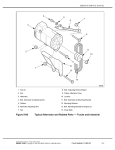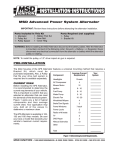Transcript
GB Troubleshooting – overrunning alternator pulley Overrunning alternator pulleys do wear out, but this is not always visible to the naked eye. Follow these simple tests to identify signs of wear: 1. On-vehicle testing Have the engine running at idle and check belt tensioner movement. If excessive, this may be the first indication of a worn overrunning alternator pulley. Rev up the engine to approximately 2000-2500 rpm. Then shut it off and listen for a buzzing sound coming from the alternator. If you hear a short buzzing sound (1 to 5 seconds), the pulley’s bearing may be worn out and the overrunning alternator pulley may require replacement. A short chirp noise during engine start-up or shut down is most likely caused by a worn overrunning alternator pulley. A worn overrunning alternator pulley often blocks and performs like a solid pulley. This will cause the belt to slip on the pulley surface and thus causes noise. 2. Off-vehicle testing If one of these tests fails, the overrunning alternator pulley should be replaced immediately: Test 1: 1. Hold the inner ring. 2. Try to rotate the outer ring in the same direction as the belt would. 3. The outer ring should not move. If it does, replace the overrunning alternator pulley. Test 2: 1. Hold the inner ring. 2. Rotate the outer ring in the opposite direction as the belt would. 3. The outer ring should rotate. If it does not, replace the overrunning alternator pulley. The OAD has an additional functionality and requires special testing. The OAD should have a smooth spring resistance in the drive direction and spin freely in the opposite direction. If not, the OAD requires replacement. Note: As the internal spring is strong, it is recommended to use special tools for the fault detection. 8530_hjulleje_GB_DE_DK






